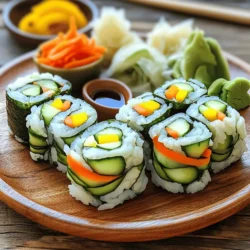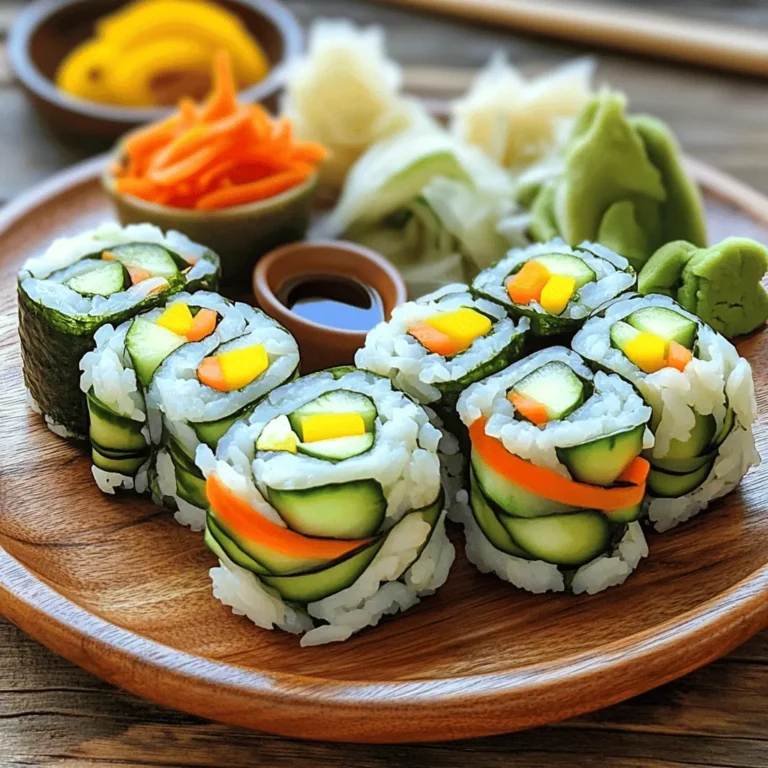If you’re looking for a fresh and healthy dish, vegetable sushi rolls are for you! Packed with colorful veggies and bursting with flavor, they make a great meal or snack. I’ll guide you through the essential ingredients, step-by-step instructions, and tips for the perfect roll. Whether you’re a beginner or a pro, this recipe will delight your taste buds. Let’s dive in and create something amazing!
Ingredients for Vegetable Sushi Rolls
Essential ingredients
To make tasty vegetable sushi rolls, you need a few key items. Here’s the list:
– 1 cup sushi rice
– 1 ¼ cups water
– 2 tablespoons rice vinegar
– 1 tablespoon granulated sugar
– ½ teaspoon salt
– 4 sheets of nori (seaweed)
– 1 medium cucumber, thinly sliced into strips
– 1 medium carrot, julienned
– ½ bell pepper (any color), thinly sliced
– 1 ripe avocado, sliced into thin wedges
These ingredients form the base of your rolls. The sushi rice is sticky and helps hold everything together. The nori provides shape and flavor.
Optional toppings
You can add a few extra touches to make your sushi rolls even better. These toppings are not required but can enhance your dish:
– Sesame seeds
– Sliced scallions
– Wasabi (for a kick)
– Extra pickled ginger
These toppings add color, flavor, and a fun twist to your rolls. Feel free to mix and match based on your taste!
Tools needed for preparation
Using the right tools makes your sushi-making easier. Here’s what you need:
– Bamboo sushi mat (for rolling)
– Sharp knife (for cutting)
– Medium saucepan (to cook rice)
– Small bowl (to mix the vinegar mixture)
– Damp cloth (to keep your hands clean)
With these tools, you will be ready to prepare your vegetable sushi rolls.
Step-by-Step Instructions
Preparation of sushi rice
To make sushi rice, start by rinsing 1 cup of sushi rice under cold water. Rinse until the water runs clear. This helps remove extra starch. Drain the rice well. Next, place the rinsed rice in a medium saucepan with 1 ¼ cups of water. Bring it to a boil over medium heat. Once boiling, cover the saucepan with a lid. Lower the heat and let it simmer for 15 minutes. All the water should absorb during this time. After cooking, keep the lid on and let it rest for 10 minutes. This step makes the rice fluffy. In a small bowl, mix 2 tablespoons of rice vinegar, 1 tablespoon of sugar, and ½ teaspoon of salt. Stir until dissolved. Fold this mixture into the warm rice. This adds flavor while cooling the rice slightly.
Assembling vegetable sushi rolls
Now, let’s roll! Place a sheet of nori shiny side down on a sushi mat or cutting board. With damp hands, spread about ¾ cup of seasoned sushi rice over the nori. Leave a 1-inch border at the top. In the middle, add strips of cucumber, carrot, bell pepper, and avocado. Arrange them in a neat row. Start rolling the sushi from the bottom edge, pulling it away from you. Use the mat to shape the roll, but don’t press too hard. When you reach the bare edge, moisten it with a bit of water to seal the roll.
Cutting and serving suggestions
Carefully slice the roll into 6-8 pieces with a sharp knife. Dipping the knife in water helps prevent sticking. Repeat this process with the remaining nori sheets and fillings. For serving, place the sushi rolls on a plate. Add a small dish of pickled ginger and soy sauce for dipping. To make it even prettier, sprinkle sesame seeds or chopped scallions on the plate. Arrange the rolls in a fan shape for a lovely visual. Enjoy your fresh vegetable sushi!
Tips & Tricks
Common mistakes to avoid
Making sushi can be tricky. Here are some common mistakes to avoid:
– Not rinsing the rice: Always rinse sushi rice. This removes excess starch.
– Overcooking the rice: Stick to the timing. Too much time can make the rice mushy.
– Filling too much: Don’t overstuff your rolls. This makes them hard to seal and slice.
– Using dry hands: Wet your hands when handling rice. It prevents sticking and mess.
How to achieve perfect rice texture
Getting the right texture for sushi rice is key. Follow these tips:
– Rinse thoroughly: Rinse until the water runs clear. This helps the rice stay firm.
– Measure water accurately: Use 1 ¼ cups of water for 1 cup of rice. This ratio is important.
– Let it rest: After cooking, let the rice sit covered for 10 minutes. This helps it fluff up.
– Add vinegar mix gently: Fold in the vinegar mixture carefully. This adds flavor without mashing the rice.
Rolling techniques for beginners
Rolling sushi might seem hard, but it’s easy with practice. Here’s how to start:
– Use a bamboo mat: Place the nori on a bamboo mat. This helps you roll tightly.
– Spread rice evenly: Spread rice to the edges but leave a border at the top.
– Add fillings in the center: Keep your fillings in a neat row. This makes rolling easier.
– Roll tightly but gently: Start rolling from the bottom. Use the mat to guide you, not too tight.
– Seal with water: Moisten the edge of the nori to seal your roll. This holds it together.
These tips will help you make perfect vegetable sushi rolls!

Variations
Different vegetable filling options
You can mix and match many veggies in your sushi rolls. Try using:
– Zucchini, sliced thin
– Spinach leaves for a fresh crunch
– Radishes for a spicy kick
– Sweet potato, roasted and mashed
– Asparagus spears for a unique taste
Each of these fillings adds flavor and color. You can even add herbs like cilantro or basil for a fresh twist.
Alternative sauces and dips
While soy sauce is classic, there are other tasty dips too. Consider these options:
– Spicy mayo for a creamy touch
– Ponzu sauce for a zesty flavor
– Wasabi for a spicy heat
– Teriyaki sauce for a sweet twist
These sauces can enhance your sushi experience. You can also mix soy sauce with sesame oil for a richer flavor.
Creative sushi roll presentations
How you present your sushi makes it even more fun. Here are some ideas:
– Cut rolls into fun shapes using cookie cutters
– Use a colorful plate for a bright display
– Arrange rolls in a circle with dipping sauces in the middle
– Garnish with microgreens or edible flowers
These ideas will impress your guests and make your meal more enjoyable. Try out different styles to find your favorite!
Storage Info
How to store leftover sushi rolls
To store leftover sushi rolls, wrap them tightly in plastic wrap. This keeps them fresh and moist. You can also place them in an airtight container. Store the rolls in the fridge for up to 24 hours for the best quality.
Best practices for maintaining freshness
To maintain freshness, keep sushi rolls cool and away from sunlight. Avoid adding sauces until you are ready to eat. If the rolls contain avocado, eat them quickly, as they brown fast.
Reheating advice for sushi rice
Sushi rice is best served fresh. If you have leftover rice, reheat it gently. Use a microwave with a damp paper towel on top. This method helps keep the rice moist and fluffy. Avoid overheating, as it can make the rice dry and hard.
FAQs
How long can I store homemade sushi rolls?
You can store homemade sushi rolls in the fridge for up to 24 hours. Make sure to wrap them tightly in plastic wrap. This helps keep them fresh and prevents them from drying out. However, the texture does change. The rice can harden, and the vegetables may lose their crispness.
Can I use brown rice instead of sushi rice?
Yes, you can use brown rice instead of sushi rice. Brown rice adds a nutty flavor and extra fiber. However, it does require a longer cooking time. You may need to adjust the water ratio and cooking method, as brown rice absorbs more water.
What other vegetables are good for sushi?
Many vegetables work well in sushi. Here are some great options:
– Spinach
– Radish
– Asparagus
– Zucchini
– Sweet potato
– Mushrooms
These veggies add color and flavor to your sushi rolls.
Is vegetable sushi suitable for vegan diets?
Yes, vegetable sushi is great for vegan diets. It contains no animal products. The main ingredients are rice and vegetables, making it a healthy choice. Just ensure your dipping sauce is also vegan, as some soy sauces may contain fish.It details all the ingredients and steps needed to create these delicious rolls. Enjoy making them at home!
Making vegetable sushi rolls is simple and fun. You learned about the key ingredients like sushi rice and fresh veggies. I showed you how to prepare, assemble, and cut your rolls. We discussed tips to avoid common mistakes and how to add your own twist with different veggies and dips. Lastly, I shared storage tips to keep your sushi fresh. Enjoy creating these rolls and impress your friends with your skills! Dive into this tasty veggie sushi journey today.


